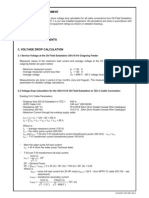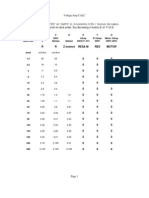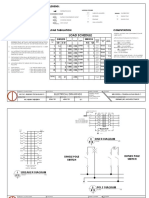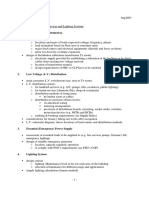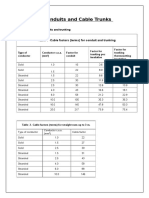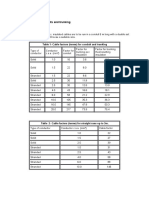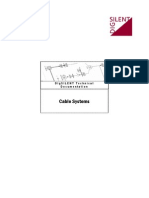Conduit Fill Calculation PDF
Conduit Fill Calculation PDF
Uploaded by
brian guevaraCopyright:
Available Formats
Conduit Fill Calculation PDF
Conduit Fill Calculation PDF
Uploaded by
brian guevaraOriginal Title
Copyright
Available Formats
Share this document
Did you find this document useful?
Is this content inappropriate?
Copyright:
Available Formats
Conduit Fill Calculation PDF
Conduit Fill Calculation PDF
Uploaded by
brian guevaraCopyright:
Available Formats
1/7/2015
Home
ElectricalEngineering
CoursesList
PDFCourses
DownloadLibrary
Instruments
InspectionPhotos
ContactUs
Aboutme
Tension Clamp for OPGW
Certificate: ISO9001:2008 Customized. Long-lasting Quality.
ConduitFillCalculations
ElectricalGround
Wire
ChinaProfessional
ManufacturerOfElectrical
GroundWire,Order
Electrical-Knowhow
RECENTARTICLES
In Article " Electrical Boxes Volume and Fill Calculations ", I explained the following items:
NEC 314.16 Part (A): Box Volume Calculations,
NEC 314.16 Part (B): Box Fill Calculations,
NEC 314.16 Part (C): Conduit Bodies.
Today, I will explain Conduit Fill Calculations as follows.
You can review the following articles in the same course for more information:
POPULARARTICLES
Types of Electrical Conduits
Electrical Boxes Part Two
Conduit Fittings and Supports
Electrical Boxes Volume and Fill Calculations
Electrical Boxes Part One
Electrical Boxes Part Two
Conduit Fittings and Supports
Conduit Fill Calculations
Electrical Boxes
Types of Electrical Conduits
Conduit Fill Calculations
Ground Resistance Calculations
Introduction to Earthing System
Ground Resistance Measurements
Conduit Sizes Designations
How To Verify Ground Connections and Fence
Ground Installation
The conduits have two size designations as follows:
BLOGARCHIVE
BlogArchive
1. Metric designator,
2. Trade size.
Table 300.1(C) identifies a distinct metric designator for each circular raceway trade size.
http://electricalinspector.blogspot.com/2013/06/conduitfillcalculations.html
1/6
1/7/2015
ElectricalEngineering
Tables used for Conduit Fill Calculations
First: Chapter 9 which includes the following tables:
TABLE 1 Percent of Cross Section of Conduit and Tubing for Conductors,
TABLE 2 Radius of Conduit and Tubing Bends,
TABLE 4 Dimensions and Percent Area of Conduit and Tubing (Areas of
Conduit or Tubing for the Combinations of Wires Permitted in Table 1,
Chapter 9),
TABLE 5 Dimensions of Insulated Conductors and Fixture Wires,
TABLE 5A Compact Copper and Aluminum Building Wire Nominal
Dimensions* and Areas,
TABLE 8 Conductor Properties.
You can download a PDF copy of Chapter 9 Tables by click on the link.
Second: Annex C Tables
Informative Annex C contains conductor fill tables for each of 12 types of conduit and
tubing. The Informative Annex C tables which are based on the dimensions given in
Tables 1 and 4 of Chapter 9 for conduit and tubing fill and on the dimensions for
conductors in Table 5 of Chapter 9 provide conductor fill information based on the
specific conduit or tubing and on the conductor insulation type, size, and stranding
characteristics. Examples of how to use these tables are included in the commentary
both here and in Informative Annex C.
You can download a PDF copy of Annex C Tables by click on the link.
Chapter 9 Table 1
Table 1 establishes the maximum fill permitted for the circular conduit and tubing types. It is the
basis for Table 4 and for the information on conduit and tubing fill provided in the Informative Annex
C tables.
http://electricalinspector.blogspot.com/2013/06/conduitfillcalculations.html
2/6
1/7/2015
ElectricalEngineering
Informational Note No. 1:
The installation of conductors in a conduit can face some difficulties due to:
1. Long length of the run or
2. Many numbers and total radius of bends.
So, it is recommended that where a difficult installation is anticipated due to above reasons, the
available solutions will be as follows:
1. The maximum number of conductors permitted not be installed, or
2. The size of the conduit or tubing be increased by at least one trade size larger than the
minimum required by the Code.
Informational Note No. 2:
Conductor jamming may occur during the installation (pulling) of conductors into a
conduit even if fill allowances of 40 percent are observed.
During the installation of three conductors or cables into the raceway, one conductor
could slip between the other two conductors. This is more likely to take place at bends,
where the raceway may be slightly oval.
The jam ratio is calculated as follows:
Jam ratio = ID of raceway / OD of conductor
To avoid difficult conductor installations and potential conductor insulation damage due to jamming
within the conduit or tubing, a jam ratio between 2.8 and 3.2 should be avoided.
As an example:
Table C.1 in Informative Annex C permits three 8 AWG conductors in trade size 12 electrical
metallic tubing (EMT). An 8 AWG conductor has an outside diameter (OD) of 0.216 in. (from Table 5),
and a 12 in. EMT has an internal diameter (ID) of 0.622 in. (from Table 4).
The jam ratio is calculated as follows:
Jam ratio = ID of raceway / OD of conductor = 0.622 / 0.216 = 2.88
So, Jamming of conductors will occur, use the next larger trade size conduit.
A 34 in. EMT has an internal diameter (ID) of 0.824 in. (from Table 4).
So, Jam ratio = ID of raceway / OD of conductor = 0.824 / 0.216 = 3.815
Chapter 9 Table 4
Because conduits and tubing from different manufacturers have different
internal diameters for the same trade size, Table 4 provides the diameter
and the actual area of different conduit and tubing types at fill
percentages of 100, 60, 53 (one wire), 31 (two wires), and 40 (more than
two wires).
The 60 percent fill is provided in Table 4 to correlate with Note 4 (found in
the Notes to Tables section of this chapter) to the conduit and tubing fill
tables, which permits conduit or tubing nipples 24 in. or less in length to
have a conductor fill of up to 60 percent.
Separate sections in Table 4 cover metal, nonmetallic, rigid, and flexible
conduit and tubing types.
Notes to chapter 9 Tables
(1) See Informative Annex C for the maximum number of conductors and fixture wires,
all of the same size (total crosssectional area including insulation) permitted in trade
sizes of the applicable conduit or tubing.
(2) Table 1 applies only to complete conduit or tubing systems and is not intended to
apply to sections of conduit or tubing used to protect exposed wiring from physical
damage.
(3) Equipment grounding or bonding conductors, where installed, shall be included
when calculating conduit or tubing fill. The actual dimensions of the equipment
grounding or bonding conductor (insulated or bare) shall be used in the calculation.
http://electricalinspector.blogspot.com/2013/06/conduitfillcalculations.html
3/6
1/7/2015
ElectricalEngineering
The dimensions of bare conductors are given in Table 8.
(4) Where conduit or tubing nipples having a maximum length not to exceed 600 mm
(24 in.) are installed between boxes, cabinets, and similar enclosures, the nipples shall
be permitted to be filled to 60 percent of their total crosssectional area, and
310.15(B)(3)(a) adjustment factors need not apply to this condition.
(5) For conductors not included in Chapter 9, such as multiconductor cables, high
voltage Cables and optical fiber cables, the actual dimensions shall be used.
The crosssectional area can be calculated in the following manner, using the actual
dimensions of each conductor:
Crosssectional area = d 2 cmil
Where:
d = outside diameter of a conductor (including insulation)
1 in. = 1000 mil
1 cmil (circular mil) = /4 (3.1416/4) square mil =0.7854 square mil.
Conversion from square millimeters to circular mils:
To convert from square millimeters to circular mils (approximately) follows:
k = 1973.53 circular mils / mm2
(6) For combinations of conductors of different sizes, use Table 5 and Table 5A for
dimensions of conductors and Table 4 for the applicable conduit or tubing dimensions.
(7) When calculating the maximum number of conductors permitted in a conduit or
tubing, all of the same size (total crosssectional area including insulation), the next
higher whole number shall be used to determine the maximum number of conductors
permitted when the calculation results in a decimal of 0.8 or larger.
(8) Where bare conductors are permitted by other sections of this Code, the
dimensions for bare conductors in Table 8 shall be permitted.
(9) A multiconductor cable or flexible cord of two or more conductors shall be treated
as a single conductor for calculating percentage conduit fill area. For cables that have
elliptical cross sections, the crosssectional area calculation shall be based on using
the major diameter of the ellipse as a circle diameter.
Example#1:
Three 15kV single conductors are to be installed in rigid metal conduit (RMC). The outside diameter of each conductor
measures 158 in., or 1.625 in. What size RMC will accommodate the three conductors?
Solution:
Step 1: Find the crosssectional area within the conduit to be displaced by the three conductors:
1.625 in. x 1.625 in. x 0.7854 x 3 = 6.2218 in.2 or 6.222 in.2
Step 2: Determine the correct conduit size to accommodate the three conductors. Table 1 allows 40 percent conduit fill for
three or more conductors, and Table 4 indicates that 40 percent of trade size 5 RMC is 8.085 in.2.
Thus, trade size 5 RMC will accommodate three 15kV single conductors.
Example#2:
What traditional wire size does the size 125 mm2 represent (approximately)?
Solution:
Circular mil area = wire size (mm2) x conversion factor = 125 mm2 x 1973.53 circular mils / mm2 = 246,691 circular mils or
246.691 kcmil
Therefore, the 125 mm2 wire is larger than 4/0 AWG (211.6 kcmil) but smaller than a 250kcmil conductor.
Notes to example#2:
If a 125 mm2 wire is determined to be the minimum or recommended size conductor, it is important to
understand that size 250 kcmil would be the only Table 8 conductor with equivalent crosssectional area because
4/0 AWG is simply not enough metal.
It is important, however, to note that the 250kcmil conductor ampacity could not be used for a 125 mm2
conductor, because the metric conductor size is smaller. The 4/0 AWG ampacity can be used, or the ampacity
can be calculated under engineering supervision.
http://electricalinspector.blogspot.com/2013/06/conduitfillcalculations.html
4/6
1/7/2015
ElectricalEngineering
Example#3:
A 200ampere feeder is routed in various wiring methods [electrical metallic tubing (EMT); rigid polyvinyl chloride conduit
(PVC), Schedule 40; and rigid metal conduit (RMC)] from the main switchboard in one building to a distribution panelboard in
another building. The circuit consists of four 4/0 AWG XHHW copper conductors and one 6 AWG XHHW copper conductor.
Select the proper trade size for the various types of conduit and tubing to be used for the feeder.
Solution:
The used tables are:
Table 1
Table 1, Note 6 refers to Table 5 for the area required for each insulated conductor.
Note 6 also refers to Table 4 for selection of the appropriate trade size conduit or tubing.
Table 4 contains the allowable cross sectional area for conduit and tubing based on conductor occupied space
(40 percent maximum in this example).
Step 1: assign the fill percentage from table 1
All the raceways for this example require conduit fill to be calculated according to Table 1 in Chapter 9, which chapter 9
table 1 permits conduit fill to a maximum of 40 percent where more than two conductors are installed.
Step 2: Calculate the total area occupied by the conductors, using the approximate areas listed in Table 5:
Four 4/0 AWG XHHW: 4 x 0.3197 in.2 = 1.2788 in.2
One 6 AWG XHHW: 1 x 0.0590 in.2 = 0.0590 in.2
Total area = 1.3378 in.2 or 1.338 in.2
Step 3: Determine the proper trade size EMT, RMC, and PVC (Schedule 40) from Table 4.
The portion of this feeder installed in EMT requires a minimum trade size 2, which has 1.342 in.2 of available space for over
two conductors. The minimum required space is 1.338 in.2, which is less than the trade size 2 EMT 40 percent fill.
RMC also requires a minimum trade size 2, because trade size 2 RMC has 1.363 in.2 of available space for over two
conductors. PVC (Schedule 40), however, requires a minimum trade size 2 12.
Trade size 2 PVC has 1.316 in.2 allowable space for over two conductors and is less than the 1.338 in.2 required for this
combination of conductors. Therefore, it is necessary to increase the PVC size to 2 12 trade size, the next standard size
increment.
Example#4:
Determine how many 10 AWG THHN conductors are permitted in a trade size 1 14 rigid metal conduit (RMC).
Solution:
Table 1 permits 40 percent fill for over two conductors.
From Table 4, 40 percent fill for trade size 114 RMC is 0.610 in., and from Table 5, the crosssectional area of a 10 AWG
THHN conductor is 0.0211 in.2.
The number of conductors permitted is calculated as follows:
0.610 in.2 / 0.0211 in.2 per conductor = 28.910 conductors
Based on the maximum allowable fill, the number of 10 AWG THHN conductors in trade size 1 14 RMC cannot exceed 28.
However, in accordance with Note 7, an increase to the next whole number of 29 conductors is permitted in this case,
because 0.910 is greater than 0.8.
In this case the number of conductors permitted = 29 conductors
Note to example#4:
Although increasing the total to 29 conductors results in the raceway fill exceeding 40 percent, the amount by which it is
exceeded is a fraction of 1 percent and will not adversely affect the installation of the conductors.
In the next Article, I will explain how to verify Area Classification and Service Requirements of Conduit, Junction Boxes
and Pull Boxes. Please, keep following.
Back to Course WR2: Inspect conduits, junction boxes, and pull boxes
http://electricalinspector.blogspot.com/2013/06/conduitfillcalculations.html
5/6
1/7/2015
ElectricalEngineering
You might also like:
ElectricalBoxes
VolumeandFill
Calculations
HowToInspect
ElectricalConduits
andBoxes
GroundResistance
Calculations
ConduitFittings
andSupports
ReviewforCourse
WR2:Inspect
Conduits,Junction
andPull...
Linkwithin
+1 Recommend this on Google
Nocomments:
PostaComment
Enteryourcomment...
Commentas:
GoogleAccount
Publish
Preview
<< 4 How To Inspect Electrical Conduits
and Boxes
0 Electrical Boxes Volume and Fill
Calculations >>
Home
Subscribe to: Post Comments (Atom)
FOLLOWERS
Jointhissite
withGoogleFriendConnect
Members(51) More
NEWARTICLES
POPULARARTICLES
Properties of Conductors
Electrical Boxes Part Two
Introduction to Fluorescent and Incandescent Light Fixtures
Inspection
Electrical Boxes Volume and Fill Calculations
Introduction to Conductor Inspection
Conduit Fittings and Supports
Course CAB1: Inspect Conductors
Conduit Fill Calculations
Review for Course WR2: Inspect Conduits, Junction and Pull
Boxes
Electrical Boxes
Types of Electrical Conduits
How To Inspect Electrical Conduits and Boxes
Alreadyamember?Signin
Conduit Fill Calculations
Electrical Boxes Volume and Fill Calculations
Ground Resistance Calculations
Introduction to Earthing System
Electrical Boxes Part Two
Ground Resistance Measurements
Electrical Boxes
How To Verify Ground Connections and Fence Ground
Installation
SUBSCRIBEVIAEMAIL
Enter your email address:
SubscribeforNewArticles
CopyRight@2013ElectricalInspectorPrivacy
Policy
Powered by Blogger.
http://electricalinspector.blogspot.com/2013/06/conduitfillcalculations.html
6/6
You might also like
- Conduit Fill Calculations NECDocument16 pagesConduit Fill Calculations NECMohammed HijaziNo ratings yet
- Instructional Material FOR EETE 10013 Philippine Electrical CodeDocument58 pagesInstructional Material FOR EETE 10013 Philippine Electrical CodeRobert Apilado100% (1)
- Nec TablesDocument21 pagesNec TablesRichard Wiltsie100% (2)
- Raceway and Box CalculationsDocument31 pagesRaceway and Box CalculationsFrancis Owusu100% (2)
- What Is The Difference Between AWA and SWA CableDocument18 pagesWhat Is The Difference Between AWA and SWA Cableafsdf100% (1)
- Raceway Sizing Getting It Just RightDocument6 pagesRaceway Sizing Getting It Just RightRobertoHerediaJacoboNo ratings yet
- Short Circuit Cable SizingDocument4 pagesShort Circuit Cable Sizingsuresh8159No ratings yet
- UPS & Battery SizingDocument0 pagesUPS & Battery SizingShrikant Kajale100% (1)
- Voltage Drop Calculation DraftDocument9 pagesVoltage Drop Calculation Draftmeeng2014No ratings yet
- DesigningConduitRuns For Cat5 CableDocument4 pagesDesigningConduitRuns For Cat5 Cablenewnse2008No ratings yet
- Multi Cable Conduit Fill CalculatorDocument2 pagesMulti Cable Conduit Fill CalculatorPraveen Kumar100% (1)
- Voltage Drop CalculatorDocument4 pagesVoltage Drop CalculatorPieter En Erna VenterNo ratings yet
- Voltage Drop Calculation SampleDocument1 pageVoltage Drop Calculation SampleRey ArthurNo ratings yet
- 1ph Control Panel Short Circuit CalculationsDocument16 pages1ph Control Panel Short Circuit Calculationsmelvyn9692100% (2)
- Short-Circuit CalculationsDocument14 pagesShort-Circuit Calculationsdaodoquang100% (2)
- An Overview of Short Circuit Current (Part 3) : Sample Calculation For Small LT SystemDocument5 pagesAn Overview of Short Circuit Current (Part 3) : Sample Calculation For Small LT SystemRobert GalarzaNo ratings yet
- Section 260526 - Grounding and Bonding For Electrical SystemsDocument6 pagesSection 260526 - Grounding and Bonding For Electrical SystemsVCNo ratings yet
- Bus BarDocument2 pagesBus BarwilmanzitoNo ratings yet
- Comments On DrawingsDocument8 pagesComments On Drawingsmdalt77No ratings yet
- Electrical System Grounding Design GuideDocument10 pagesElectrical System Grounding Design Guideap00No ratings yet
- LT Cable Sizing Calculation SheetDocument12 pagesLT Cable Sizing Calculation Sheet2003vinay100% (5)
- Attachment Cable Sizing CalculationDocument1 pageAttachment Cable Sizing CalculationnourfarmajidNo ratings yet
- Electrical Power Plans For Building ConstructionDocument16 pagesElectrical Power Plans For Building ConstructionKitz DerechoNo ratings yet
- Electrical Thumb Rules-Illumination - (Part-17) - Electrical Notes & ArticlesDocument19 pagesElectrical Thumb Rules-Illumination - (Part-17) - Electrical Notes & ArticlesElectrical RadicalNo ratings yet
- Can We Operate A 60HZ Transformer On 50Hz Supply Source and Vice VersaDocument9 pagesCan We Operate A 60HZ Transformer On 50Hz Supply Source and Vice VersaKrishna JashaNo ratings yet
- Demand FactorDocument23 pagesDemand FactorVic Diaco100% (1)
- Electrical DesignDocument1 pageElectrical DesignAlfred OkacheNo ratings yet
- Supplying Power For Electric Fire Pumps-Pacuku-CEEDocument5 pagesSupplying Power For Electric Fire Pumps-Pacuku-CEEJOSE LUIS FALCON CHAVEZNo ratings yet
- 2.battery SizingDocument14 pages2.battery SizingPrabhash Verma0% (1)
- Cable Sizing CalculationDocument1 pageCable Sizing Calculationmathan_aeNo ratings yet
- Cable Sizing Design Basis - DraftDocument11 pagesCable Sizing Design Basis - DraftIman Mukherjee100% (1)
- Conduit Sizing CalculationDocument17 pagesConduit Sizing CalculationAbdelKarim Baarini100% (1)
- Electrical DrawingsDocument5 pagesElectrical DrawingsAnne DudeNo ratings yet
- ShortCircuitCalculations ReactanceDocument17 pagesShortCircuitCalculations ReactanceVinay ChandranNo ratings yet
- Earth Loop Impedance CalculationsDocument4 pagesEarth Loop Impedance Calculationsbstack10No ratings yet
- Determination of Voltage DropDocument5 pagesDetermination of Voltage DropaimizaNo ratings yet
- Motor Cable SizingDocument2 pagesMotor Cable Sizingricky tindocNo ratings yet
- ELECTRICAL DESIGN InternDocument35 pagesELECTRICAL DESIGN Internomair sirajNo ratings yet
- UPS Battery SizingDocument2 pagesUPS Battery SizingAbhijeet Durge100% (1)
- For Reference: General Notes Abbreviations Life Safety Systems LegendDocument1 pageFor Reference: General Notes Abbreviations Life Safety Systems LegendOfer Ben-MosheNo ratings yet
- Element D: D5000 Load Calculation CriteriaDocument3 pagesElement D: D5000 Load Calculation CriteriaAnil Singh100% (1)
- Electrical Cabling & UPS InstallationDocument107 pagesElectrical Cabling & UPS InstallationSheikh Waqar AliNo ratings yet
- Cable Sizing & VDCDocument39 pagesCable Sizing & VDCMohammad JaradehNo ratings yet
- Electrical Load CalculationDocument1 pageElectrical Load Calculationnick_a_garciaNo ratings yet
- Selection of Main & Branch CB As Per NEC-210 (14.1.14)Document16 pagesSelection of Main & Branch CB As Per NEC-210 (14.1.14)casaouis02100% (1)
- Electrical and Lighting System Design (HKU)Document2 pagesElectrical and Lighting System Design (HKU)李梓誠No ratings yet
- Amtech Cable Sizing GuideDocument6 pagesAmtech Cable Sizing GuideKhanSA786No ratings yet
- Applications To Sizing Circuit Breakers (ANSI C37)Document22 pagesApplications To Sizing Circuit Breakers (ANSI C37)freddy riveraNo ratings yet
- Lecture 2b PDFDocument91 pagesLecture 2b PDFAntonNo ratings yet
- Sizing Conduit and Tubing by Bill BamfordDocument8 pagesSizing Conduit and Tubing by Bill Bamfordraul_bsuNo ratings yet
- Cable Tray Rules PDFDocument8 pagesCable Tray Rules PDFHafiz Muhammad Ahmad RazaNo ratings yet
- Design of Cable RoutesDocument10 pagesDesign of Cable Routesarun100% (1)
- How To Use Chapter 9 NEC in Your Next DesignDocument2 pagesHow To Use Chapter 9 NEC in Your Next DesignromoNo ratings yet
- Cable Capacity of Conduits and TrunkingDocument11 pagesCable Capacity of Conduits and TrunkingarunNo ratings yet
- JKR Elektrik-Saiz CableDocument8 pagesJKR Elektrik-Saiz Cablearchery67% (3)
- 2011 NEC Code 310.15B3cDocument7 pages2011 NEC Code 310.15B3cKhaldoon AlnashiNo ratings yet
- 0500 CalcsDocument2 pages0500 Calcsarmin_fernandezNo ratings yet
- 14F3099X00 Ampacity Wire WisdomDocument2 pages14F3099X00 Ampacity Wire WisdomAnonymous IvZSKJCNo ratings yet
- TechRef CableConstants PDFDocument21 pagesTechRef CableConstants PDFRafat ThongNo ratings yet
- MCCableFlyer 0215updateDocument2 pagesMCCableFlyer 0215updateMiguel Blasco MartínezNo ratings yet
- EET 4 Calculation of The Cross-Sectional Areas of Circuit Live Conductors and CablesDocument4 pagesEET 4 Calculation of The Cross-Sectional Areas of Circuit Live Conductors and CablesLinus AbokiNo ratings yet
- Iso 6722 2006 en PDFDocument11 pagesIso 6722 2006 en PDFRavendra SinghNo ratings yet
- Karam - FLS Export Catalog-2019Document52 pagesKaram - FLS Export Catalog-20191pallabNo ratings yet
- Cable Instrumentación Apantallado 8x2x16AWG 300V 90°C Libre de Halógeno, UL, X MDocument1 pageCable Instrumentación Apantallado 8x2x16AWG 300V 90°C Libre de Halógeno, UL, X MDiana SalasNo ratings yet
- Technical News: Cables Used in Intrinsically Safe CircuitsDocument1 pageTechnical News: Cables Used in Intrinsically Safe CircuitsFelipe GustavoNo ratings yet
- Electric Wires and CablesDocument9 pagesElectric Wires and Cableswafikmh4No ratings yet
- Electrical WiringDocument52 pagesElectrical Wiringbharti dhoteNo ratings yet
- Pilot Cable Specs FewaDocument13 pagesPilot Cable Specs Fewabharat_22nandulaNo ratings yet
- Control System of The Wiredrawing Machine1Document8 pagesControl System of The Wiredrawing Machine1Vadim CazacNo ratings yet
- Material CHECK LIST - TransformerDocument8 pagesMaterial CHECK LIST - TransformerHussainShabbirNo ratings yet
- Organizational Chart of Laus Automotiv Group Showroom ConstructionDocument1 pageOrganizational Chart of Laus Automotiv Group Showroom ConstructionHeiro KeystrifeNo ratings yet
- Service Manual: Twin-Tub Washing MachineDocument17 pagesService Manual: Twin-Tub Washing MachineJashanpreet kaurNo ratings yet
- Plugs & Sockets 01.11.2020Document3 pagesPlugs & Sockets 01.11.2020RITESH SENTANo ratings yet
- Module 10 LoadcentersDocument25 pagesModule 10 Loadcenterseyd bartulabaNo ratings yet
- Att TP 76300 KDocument20 pagesAtt TP 76300 KdlstoneNo ratings yet
- PT Pipa Mas PutihDocument43 pagesPT Pipa Mas Putihsultanbona99No ratings yet
- Web and Felt GuidingDocument18 pagesWeb and Felt Guidingluiz almeidaNo ratings yet
- BRC Mesh Suppliers Malaysia)Document12 pagesBRC Mesh Suppliers Malaysia)Setsuna F. SeieiNo ratings yet
- Materials Data: Perforated, Expanded Metal and Wire Cloth MediaDocument1 pageMaterials Data: Perforated, Expanded Metal and Wire Cloth MediaRajNo ratings yet
- Electrification Products Price ListDocument95 pagesElectrification Products Price Listfadell alrekabiNo ratings yet
- Electromagnet ActivityDocument3 pagesElectromagnet ActivitySab DicoNo ratings yet
- MIL-W-22759 Rev E - Part22Document1 pageMIL-W-22759 Rev E - Part22David WongNo ratings yet
- Armour Loss in Three-Core Submarine Xlpe Cables PDFDocument1 pageArmour Loss in Three-Core Submarine Xlpe Cables PDFFrido Feby AriyantoNo ratings yet
- AWG A Kcmil A mm2Document2 pagesAWG A Kcmil A mm2Santiago MarcialNo ratings yet
- E6s Wiring DiagramDocument1 pageE6s Wiring Diagramandres felipe jimenez cordobaNo ratings yet
- Tianjie Shielded Fire Alarm Cable 1.5mm2x2C SOLID PVCDocument2 pagesTianjie Shielded Fire Alarm Cable 1.5mm2x2C SOLID PVCRaton121 RahmanNo ratings yet
- Electrical Installation For Ground Floor For G+2Document2 pagesElectrical Installation For Ground Floor For G+2Welday GebremichaelNo ratings yet
- Belden 9842 Data SheetDocument2 pagesBelden 9842 Data SheetRogerio Henrique SilveiraNo ratings yet
- Painting Insulation WorkDocument47 pagesPainting Insulation WorkRjeb mohamed100% (1)









